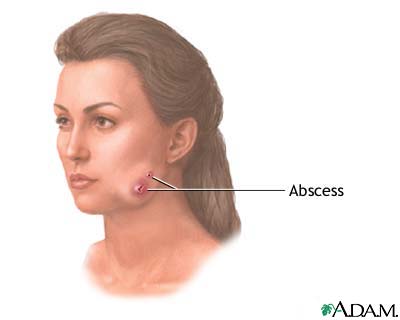

The abscess will need to drain for several days you don’t want it sealing over and getting big again. Make the slit long enough that it will stay open for drainage. The incision should be made at the lower edge of the soft area, for best drainage, making a vertical slit, which is less likely to cut blood vessels than with a horizontal slice. If you haven’t done this before and are not comfortable doing it yourself, have your veterinarian do it. If the lump is low on the jaw or near the throat area, be very careful to not slice into vital structures like the jugular vein or carotid artery. Make sure the animal is well restrained while you are trying to lance the abscess. If pus comes out of it, or there is pus on the tip when you withdraw it, the lump is ready to lance.

Poke a large-diameter hypodermic needle into the soft center of the lump. Restrain the animal in a head-gate and tie the head to the side so it can’t move around. First, however, you can check to see if there is pus in the lump before you try to slice it open. Often when you palpate those (feel the lump with your fingers) you can tell they have a softer center and you know there’s pus there. You need to wait until the infection comes to a head (with a pocket of pus) before you can do any good by lancing it. Sometimes the abscess will break and drain on its own, but it will heal faster if you can lance and flush it out. There may be some scarring-accumulation of granulation tissue and a residual small bump-but most cases clear up completely. The basic treatment is to open the abscess and establish drainage. Systemic antibiotics circulating around the body in the blood don’t get to the abscess. Systemic antibiotics are generally not needed because it’s a local infection, and doesn’t have much contact with the bloodstream. These will usually heal with just one flushing treatment If you know it’s an abscess, it can be opened to drain and flush out. There’s not a lot you can do to prevent soft tissue abscesses in the mouth that show up as lumps on the outside of the face, except avoid weedy hay that contains sharp material like cheat grass seeds or foxtail awns. In some part of the country cattle are fed a lot of cornstalks and beanstalks, and these may contain a lot of fibrous, tough material that could puncture the inner parts of the mouth. Any kind of coarse feed could cause injury, and seed heads with sharp awns may poke into the mouth tissues and become embedded. Many types of feed can cause abrasions and damage to the gums or cheek tissues. Lump in the cheek area of the mouth on the side of the face The bony lump is very hard and immobile-enlargement of the bone itself-whereas the soft tissue abscess can be moved around under the skin. Once you’ve felt the difference between the two types of lumps, they are easy to differentiate. One way to tell the difference is whether the lump is moveable in the soft tissue or firmly attached to the bone. By contrast, bony lumps don’t appear until later in life-in 2-year-olds or older. Soft tissue abscesses may occur in cattle at any age, including baby calves, if they are chewing on coarse feed. These lumps are usually due to foxtail, cheat grass or some other sharp material in the feed that penetrates or lodges in the lining of the mouth and allows bacteria to enter and create an infection.Ībscesses in the soft tissue are common, and generally caused by a variety of bacteria including Actinobacillus, which is the same bacterium associated with wooden tongue. Many cattle develop swellings/abscesses in soft tissue of the mouth, in the cheek area. Diseases And Conditions Bovine Mouth Abscess


 0 kommentar(er)
0 kommentar(er)
